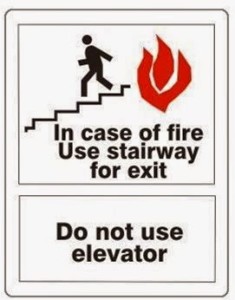
We’ve all seen the signage in elevator lobbies to use the stairs in event of fire. Some signs even say the elevators are out of service in event of fire, but that’s not always true. People may become unsure of what to do when they see an elevator door open on the 30th floor during a fire alarm. The door beckons them but the signage tells them to do otherwise. I was recently asked that if the elevators are still running, why shouldn’t a building’s occupants use the elevators to evacuate when the fire alarm activates? It’s a good question, as I used to ask that question myself.
Even though the cabs may be safe to use, most occupants still should not use them during an evacuation. Here’s why: The status of the elevator is unknown to the person waiting for the elevator to arrive. We push the button and just wait for the cab to get there. Most people get irritated if it takes more than a minute, but they keep waiting (or keep pushing the button). During a fire alarm evacuation, if the cabs have been automatically recalled by a smoke detector or manually by the fire department, the person will be waiting for a cab that will never come, losing valuable evacuation time. Additionally, if everyone tries to use the elevators to evacuate, you could be waiting a long time until it gets there and it’ll probably be full when it does get there (think hotels at checkout time). If the person waiting has mobility issues, that waiting time becomes more critical. Even if you do get on, it would probably stop at more than a few floors on the way down, possibly even the floor that has the fire. One more issue is that given the nature of the situation, people may overload the elevator, activating the safety functions that would prevent the cab from moving.
Fire officials want people to evacuate as quickly and safely as possible, so the signage is a preventive measure to help ensure that’s accomplished. Besides the practical reason for the signage, the official reason is that the International Building Code (IBC) Section 3002.3 calls for this signage at all elevators that are not specially designated as an accessible or occupant self-evacuation means of egress. These types of elevators are not typical elevators and have their own, distinct signage letting you know that they’re meant for evacuation, so assume that most of the elevators you encounter are standard public access elevators that should not be used to evacuate a building during a fire alarm.
When you use Affiliated Fire Systems for your fire alarm project, you’re getting this kind of experience across the board. Contact us to start the smoothest fire alarm project you’ve ever done. Thanks for reading!
Gene


When running safety drills, it is important to stress to your building’s inhabitants that elevators should never be used when an alarm goes off, even if it’s just a drill. Besides, drills are in place to give people a way to practice their reactions and responses in case of a real emergency. Elevators are simply unsafe to ride while experiencing a safety threat, such as a fire.